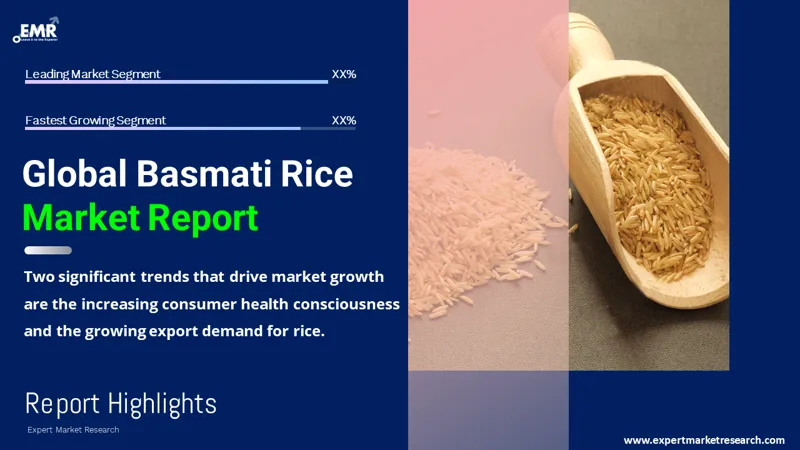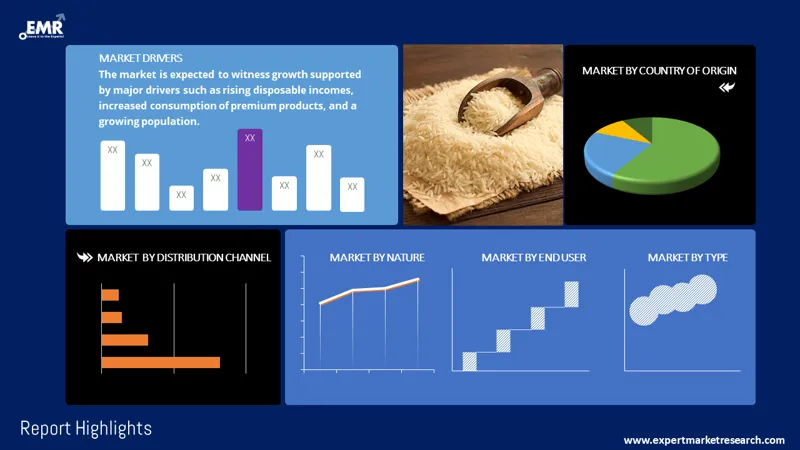
Consumer Insights
Uncover trends and behaviors shaping consumer choices today
Procurement Insights
Optimize your sourcing strategy with key market data
Industry Stats
Stay ahead with the latest trends and market analysis.
Trending Now



The global basmati rice market, valued at USD 6.34 Billion in 2024, has experienced significant growth, driven by diverse market segments such as organic, fortified, and ready-to-cook rice products, addressing varied consumer demands. The market is projected to grow at a compound annual growth rate (CAGR) of 2.00% from 2025 to 2034, potentially reaching USD 7.73 Billion by 2034. This growth is further supported by the growing perception of Basmati rice as a healthier alternative to regular rice, typically offering a lower glycemic index, which is beneficial for diabetics and health-conscious individuals.
Base Year
Historical Year
Forecast Year
Saudi Arabia is the second-largest importer of Indian basmati rice, with a 17.1% share of total exports, according to APEDA. This positions Saudi Arabia as a key player in India’s basmati rice market, reinforcing trade partnerships and contributing to the overall growth of Basmati exports.
Iraq accounts for 12.3% of India’s basmati rice exports, positioning it as a significant market. The growing demand from Iraq highlights the region's increasing preference for basmati rice, supporting India’s position as the leading global exporter and enhancing its market diversification.
North America imported USD 0.31 billion worth of basmati rice, capturing only an 8% market share in India’s basmati rice exports. This reflects potential growth opportunities for India in the North American market, indicating prospects for increasing market penetration and export value.






Value in USD Billion
2025-2034
Basmati Rice Market Outlook
*this image is indicative*
| Global Basmati Rice Market Report Summary | Description | Value |
| Base Year | USD Billion | 2024 |
| Historical Period | USD Billion | 2018-2024 |
| Forecast Period | USD Billion | 2025-2034 |
| Market Size 2024 | USD Billion | 6.34 |
| Market Size 2034 | USD Billion | 7.73 |
| CAGR 2018-2024 | Percentage | XX% |
| CAGR 2025-2034 | Percentage | 2.00% |
| CAGR 2025-2034 - Market by Region | Asia Pacific | 2.8% |
| CAGR 2025-2034 - Market by Country | India | 4.7% |
| CAGR 2025-2034 - Market by Country | UK | 3.2% |
| CAGR 2025-2034 - Market by Type | Parboiled | 2.9% |
| CAGR 2025-2034 - Market by Distribution Channel | Supermarkets and Hypermarkets | 3.4% |
| Market Share by Country | UK | 4.3% |
The growth of the basmati rice market is driven by its central role in Middle Eastern cuisine, where it is used to prepare rich dishes that feature layers of rice, meat, and dried fruits. Basmati rice also forms a part of the staple diet of many cultures, thus boosting its consumption globally. Besides, the basmati rice demand forecast indicates that the increasing export demand from various countries in the Middle East has further led to the fast rate of rice cultivation in most major geographic regions. Other important large importing countries are the USA and Europe.

Read more about this report - REQUEST FREE SAMPLE COPY IN PDF
As per the Agricultural & Processed Food Products Export Development Authority (APEDA), for India's basmati rice export market, Iran emerges as the largest importer, accounting for 25.3% of the total exports, followed by Saudi Arabia with 17.1% and Iraq with 12.3%. These three countries alone account for a significant basmati rice market share, highlighting the strong demand for basmati rice in the Middle East. The United Arab Emirates and Yemen also contribute notable shares, with 6.5% and 5.2%, respectively, reinforcing the Middle Eastern dominance.
The basmati rice industry analysis also states that the United States (4.1%) and Kuwait (3.7%) are prominent non-Middle Eastern buyers, while the United Kingdom (3.3%), Oman (2.0%), and Qatar (1.8%) account for smaller shares. The overall trend shows a concentrated demand in the Middle East, driven by inventory-building efforts and a willingness to pay higher prices. This reflects the regional preference and robust market potential for India's basmati rice.
The growth of the basmati rice market is driven by an increase in health-conscious consumers, technological advancements in rice cultivation, the expansion of basmati rice in ready-to-cook segments, and a rise in basmati rice exports.
As health awareness increases, consumers are opting for basmati rice due to its lower glycemic index compared to standard rice, making it particularly popular among those with diabetes and health-conscious individuals. This shift is further reinforced by the growing demand for organic and fortified varieties, as people worldwide favour natural, nutrient-rich foods. Basmati rice is increasingly viewed as a healthier alternative to other rice types, driving market expansion. India and Pakistan, the leading producers of basmati rice, have successfully established a robust export market that ensures a steady supply, supporting the product’s continued demand in global markets.
Technological advancements in rice cultivation are significantly enhancing the production of basmati rice. Innovations such as the use of drones for precision farming, coupled with the development of high-yielding, disease-resistant rice varieties, are improving crop yields while lowering costs. These technological improvements also contribute to sustainability, enabling producers to meet the rising global demand for basmati rice more efficiently. Furthermore, the introduction of the FCI Grievance Redressal System (FCI GRS) mobile app in 2024 is designed to enhance transparency, accountability, and stakeholder satisfaction, further supporting the rice millers and food security system within India’s agricultural landscape.
The demand for convenience foods, especially ready-to-cook basmati rice products, is driving the growth of this segment in global markets. As busy lifestyles become more prevalent, consumers increasingly seek time-saving meal options. In response, manufacturers are developing pre-cooked and instant basmati rice varieties that cater to the needs of modern consumers. LT Foods, for example, launched the Daawat Biryani Kit in April 2024, offering consumers a convenient way to prepare authentic biryani at home. This move reflects the company’s commitment to convenience, health, and innovation, with plans to expand its global presence and meet evolving consumer demands in over 60 countries.
India and Pakistan continue to dominate the global basmati rice export market, with India holding a significant share. Key regions such as Iran, Saudi Arabia, and Iraq are major export destinations, with demand driven by the cultural importance of basmati rice in traditional cuisines. This demand is expected to rise steadily as these countries continue to favour basmati rice. Although East and South Asia show potential for growth, India’s market share remains limited in these regions, indicating strong competition from local producers or a need for tailored products. By identifying niche markets and adapting to local preferences, India has opportunities to expand its exports further.
The growth of the basmati rice market is driven by the expanding global population and increasing disposable incomes. Additionally, the rising popularity of ethnic cuisines, organic foods, and speciality rice varieties further strengthens the market. Trade agreements also offer new opportunities for exporters by opening markets and lowering tariffs.
The value of imports to North Africa comes to USD 0.23 billion, while India's market share is only 6 percent in the region. Economic factors, coupled with tough competition from other rice-exporting countries, play a role here. Because the market share is small, there is enough reason for India to work on its competitive advantage by focused marketing strategies and overcoming logistic problems to expand in North Africa.
The overall basmati rice demand growth in FY24 reflect high regional disparities, driven by various consumer preferences, competitive landscapes, and economic conditions. While the GCC is the largest market, other important markets with growth potential are Other West Asia, Europe, and North America. On the other hand, there are regions like ASEAN, East Asia, and South Asia that have a lot of challenges but come out as strategic opportunities for market expansion.

Read more about this report - REQUEST FREE SAMPLE COPY IN PDF
The EMR’s report titled “Global Basmati Rice Market Report and Forecast 2025-2034” offers a detailed analysis of the market based on the following segments:
Market Breakup by Type:
Market Breakup by Nature:
Market Breakup by Country of Origin:
Market Breakup by End User:
Market Breakup by Distribution Channel:
Market Breakup by Region:
| CAGR 2025-2034 - Market by | Type |
| Parboiled | 2.9% |
| Raw | XX% |
| CAGR 2025-2034 - Market by | Distribution Channel |
| Supermarkets and Hypermarkets | 2.2% |
| Speciality Store | 2.1% |
| Convenience Store | XX% |
| Others | XX% |
| 2024 Market Share by | Region |
| Middle East and Africa | 29.6% |
| North America | XX% |
| Europe | XX% |
| Asia Pacific | XX% |
| Latin America | XX% |
According to the basmati rice market analysis, the Asia Pacific is the leading rice producing region, with India and Pakistan as the key markets. The region accounts for almost 90% of the global rice production. China is the leading rice producer, followed by India. However, basmati rice, specifically, is primarily grown in India and Pakistan.
| Market Share by | Country |
| UK | 4.3% |
| USA | XX% |
| Canada | XX% |
| Germany | XX% |
India is the largest producer of basmati rice, accounting for over 70% of its global output. Basmati rice consumption India is quite high as rice is among the staple diets of India. In 2018, its production attained almost 5.03 million tons. The country is also the leading exporter of basmati rice. The strengthening exports is a combined result of an increasing demand from Iran and the rise in prices that have been taking place over the last three years.
Haryana, Punjab, Himachal Pradesh, Uttarakhand, Uttar Pradesh, Jammu and Kashmir, and Delhi are the major basmati rice producing states in India. In Pakistan, the Punjab province is the largest producer of the paddy crop.
The Middle East and Africa is a significant consumer of basmati rice, which accounts for 37.5% of their total consumption of the paddy crop. GCC countries are the major importers of the basmati variety of the paddy crop. The steady increase in imports from Saudi Arabia and Iran is driving the rise of Indian exports of basmati rice.
The North American market remains focused on niche markets and ethnic communities where there is a preference for authentic Basmati rice. Importers in this region give precedence to the building of robust supply chains with reliable producers in India and Pakistan. Besides, the product differentiation is given in the form of organic and specialty rice types to cater to the health-conscious and gourmet consumers. While marketing, the features such as aroma, flavour, and health attributes are highlighted, placing Basmati in the premium category to favour the changing basmati rice market dynamics and trends.
| CAGR 2025-2034 - Market by | Country |
| India | 4.7% |
| UK | 3.2% |
| China | 2.7% |
| Saudi Arabia | 2.5% |
| Australia | 2.3% |
| USA | XX% |
| Canada | 1.9% |
| Germany | XX% |
| France | XX% |
| Italy | XX% |
| Japan | XX% |
| Brazil | XX% |
| Mexico | XX% |
The quality and sustainability standards are very stringent in the European markets, since consumer preference is for high-quality and sustainably produced food there. The certified producers in India and Pakistan work in conjunction with importers and retailers to ensure EU compliance. Much attention is given to organic and fair-trade certification as a means of attracting environmentally and socially aware consumers. The marketing strategies in Europe focus on the cultural heritage and high quality of Basmati rice, targeting gourmet markets and food enthusiasts. Besides, it reduces carbon footprints while boosting traceability through responsible sourcing.
The Middle East, and more specifically the GCC markets, presents a potential and current huge market for Basmati rice, based on cultural preference and high consumption. Close trade relationships with major producers in India and Pakistan are nurtured by importers in this region. Competitive pricing and ability to meet large demand are important. The Middle East market is focused on the stability of the supply chain and the quality of Basmati rice imports. Strategic partnerships and long-term contracts with key exporters are the most common routes to market share.
In other regions, for example, Africa and Latin America, the strategies principally aim at increasing market penetration and brand recognition. To further augment the growth of the basmati rice market, importers initially target the growing middle-class populations and urban centres with increasing demand for high-end food products.
Overall, competitive strategies adopted by firms in the global basmati rice market, those that best fit the demand and tastes in each region, are bound to ensure continued growth and presence in the market.
The basmati rice market key players have broadened their product offerings to include ready-to-eat meals, frozen foods, spices, and various other packaged food items. These companies serve a wide-ranging domestic and international clientele, exporting to numerous countries around the globe. Committed to upholding consistent quality, fostering innovation, and ensuring customer satisfaction, they operate state-of-the-art production facilities and maintain extensive distribution networks. Their continuous growth and expansion reinforce their standing as prominent leaders in the global food industry.
Founded in 1983 and headquartered in New Delhi, India, KRBL Limited is one of the largest basmati rice producers globally. The company is best known for its flagship brand, "Kohinoor," and offers a diverse range of rice and food products. KRBL has a significant presence in domestic and international markets, with operations spanning across 80 countries.
Established in 1989, Kohinoor Foods Limited is headquartered in New Delhi, India. The company is renowned for its premium quality basmati rice and diverse food products, including spices, frozen meals, and ready-to-eat dishes. With a strong presence both domestically and internationally, Kohinoor Foods is committed to delivering high-quality products to global consumers.
Adani Wilmar Limited, a joint venture between the Adani Group and Wilmar International, was founded in 1999 and is headquartered in Mumbai, India. The company is a leader in edible oils, food products, and agricultural commodities. Its flagship brand "Fortune" is widely recognised, and Adani Wilmar serves both Indian and global markets with a vast product range.
Founded in 2005, Dunar Foods Ltd. is headquartered in New Delhi, India, and specialises in the production of high-quality basmati rice. The company’s flagship brand, "Dunar," is well-regarded for its premium rice products, which are exported globally. Dunar Foods is known for its innovative milling and packaging processes, ensuring consistent product quality and customer satisfaction.
*Please note that this is only a partial list; the complete list of key players is available in the full report. Additionally, the list of key players can be customized to better suit your needs.*
Other key players in the basmati rice market report are Ebro Foods, S.A., Lundberg Family Farms, New Bharat Group, Supple Tek Pvt Ltd, LT Foods Limited, HAS Rice Pakistan, Latif Rice Mills Pvt. Ltd., and A.I.Z Import & Export, among others.
*While we strive to always give you current and accurate information, the numbers depicted on the website are indicative and may differ from the actual numbers in the main report. At Expert Market Research, we aim to bring you the latest insights and trends in the market. Using our analyses and forecasts, stakeholders can understand the market dynamics, navigate challenges, and capitalize on opportunities to make data-driven strategic decisions.*
Get in touch with us for a customized solution tailored to your unique requirements and save upto 35%!
In 2024, the basmati rice market reached an approximate value of USD 6.34 Billion.
The major market drivers are rising disposable incomes, increased consumption of premium products, and increasing population.
The increasing health consciousness among consumers and rising export demand for rice are the key trends driving the market growth.
Asia Pacific, North America, Latin America, Europe, the Middle East and Africa are the major regional markets.
The major types of rice are raw and parboiled.
Retail packaging and institutional packaging are the different pack sizes in the market.
The major producing countries are India, and Pakistan, among others.
The major players in the basmati rice market are KRBL Limited, Kohinoor Foods Limited, Adani Wilmar Limited, Dunar Foods Ltd., Ebro Foods, S.A., Lundberg Family Farms, New Bharat Group, Supple Tek Pvt Ltd, LT Foods Limited, HAS Rice Pakistan, Latif Rice Mills Pvt. Ltd., and A.I.Z Import & Export, among others.
The market is assessed to grow at a CAGR of 2.00% between 2025 and 2034.
The market is estimated to witness healthy growth in the forecast period of 2025-2034 to reach a value of around USD 7.73 Billion by 2034.
Explore our key highlights of the report and gain a concise overview of key findings, trends, and actionable insights that will empower your strategic decisions.
| REPORT FEATURES | DETAILS |
| Base Year | 2024 |
| Historical Period | 2018-2024 |
| Forecast Period | 2025-2034 |
| Scope of the Report |
Historical and Forecast Trends, Industry Drivers and Constraints, Historical and Forecast Market Analysis by Segment:
|
| Breakup by Type |
|
| Breakup by Nature |
|
| Breakup by Country of Origin |
|
| Breakup by End User |
|
| Breakup by Distribution Channel |
|
| Breakup by Region |
|
| Market Dynamics |
|
| Competitive Landscape |
|
| Companies Covered |
|
Datasheet
One User
USD 3,499
USD 3,149
tax inclusive*
Single User License
One User
USD 5,599
USD 5,039
tax inclusive*
Five User License
Five User
USD 6,999
USD 5,949
tax inclusive*
Corporate License
Unlimited Users
USD 8,459
USD 7,190
tax inclusive*
*Please note that the prices mentioned below are starting prices for each bundle type. Kindly contact our team for further details.*
Flash Bundle
Small Business Bundle
Growth Bundle
Enterprise Bundle
*Please note that the prices mentioned below are starting prices for each bundle type. Kindly contact our team for further details.*
Flash Bundle
Number of Reports: 3
20%
tax inclusive*
Small Business Bundle
Number of Reports: 5
25%
tax inclusive*
Growth Bundle
Number of Reports: 8
30%
tax inclusive*
Enterprise Bundle
Number of Reports: 10
35%
tax inclusive*
How To Order
Our step-by-step guide will help you select, purchase, and access your reports swiftly, ensuring you get the information that drives your decisions, right when you need it.

Select License Type
Choose the right license for your needs and access rights.

Click on ‘Buy Now’
Add the report to your cart with one click and proceed to register.

Select Mode of Payment
Choose a payment option for a secure checkout. You will be redirected accordingly.
Track prices with detailed trend reports.

Analyse trade data for supply chain insights.

Leverage cost reports for smart savings

Enhance supply chain with partnerships.

Gain insights to stay ahead and seize opportunities.

Get insights & trends for a competitive edge.

Track prices with detailed trend reports.

Analyse trade data for supply chain insights.

Leverage cost reports for smart savings

Enhance supply chain with partnerships.

Gain insights to stay ahead and seize opportunities.

Get insights & trends for a competitive edge.

Track prices with detailed trend reports.

Analyse trade data for supply chain insights.

Connect For More Information
Our expert team of analysts will offer full support and resolve any queries regarding the report, before and after the purchase.
Our expert team of analysts will offer full support and resolve any queries regarding the report, before and after the purchase.
We employ meticulous research methods, blending advanced analytics and expert insights to deliver accurate, actionable industry intelligence, staying ahead of competitors.
Our skilled analysts offer unparalleled competitive advantage with detailed insights on current and emerging markets, ensuring your strategic edge.
We offer an in-depth yet simplified presentation of industry insights and analysis to meet your specific requirements effectively.



Australia
63 Fiona Drive, Tamworth, NSW
+61-448-061-727
India
C130 Sector 2 Noida, Uttar Pradesh 201301
+91-723-689-1189
Philippines
40th Floor, PBCom Tower, 6795 Ayala Avenue Cor V.A Rufino St. Makati City,1226.
+63-287-899-028, +63-967-048-3306
United Kingdom
6 Gardner Place, Becketts Close, Feltham TW14 0BX, Greater London
+44-753-713-2163
United States
30 North Gould Street, Sheridan, WY 82801
+1-415-325-5166
Vietnam
193/26/4 St.no.6, Ward Binh Hung Hoa, Binh Tan District, Ho Chi Minh City
+84-865-399-124
United States (Head Office)
30 North Gould Street, Sheridan, WY 82801
+1-415-325-5166
Australia
63 Fiona Drive, Tamworth, NSW
+61-448-061-727
India
C130 Sector 2 Noida, Uttar Pradesh 201301
+91-723-689-1189
Philippines
40th Floor, PBCom Tower, 6795 Ayala Avenue Cor V.A Rufino St. Makati City, 1226.
+63-287-899-028, +63-967-048-3306
United Kingdom
6 Gardner Place, Becketts Close, Feltham TW14 0BX, Greater London
+44-753-713-2163
Vietnam
193/26/4 St.no.6, Ward Binh Hung Hoa, Binh Tan District, Ho Chi Minh City
+84-865-399-124
Share